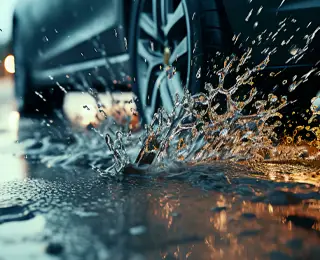Choosing the Best Tires for Rainy and Wet Conditions
The right tires can have a big impact on comfort, control, road noise, and safety. When facing winter driving conditions, snow tires are a smart choice. During other times of the year, all-season, summer or performance, as well as all-weather tires work great. But what are the best tires for rain and driving on wet roads? Are there rain tires that can help you avoid hydroplaning? We have some tips to help you understand your tire options.
Factors to Consider When Shopping for Wet Season Tires
Almost every region has a rainy season, even if it only lasts a few days. When that rain hits, you want a good set of tires to help keep you in control. Especially when dirt, oil, and other automotive fluids wash out of the pavement and come between your tires and the road, causing some slippery conditions.
Are your tires rain-ready? Here are some things to check.

Tire Grooves and Tread Design
The grooves and tread design of your tires are important. For wet driving, circumferential grooves work best to move water away from the tires and maintain a grip on the road. If the tread lines on your tires wrap around the entire tire, you have circumferential grooves.
Rubber Compound
The rubber compound in all-season as well as all-weather, performance/summer tires is designed to grip the road in warm weather. All-season and all-weather tires can even handle mild winter conditions. This gives these tires good traction and grip in wet weather.
Contact Patch
Where the tire touches the road is called the contact patch. Tires designed for wet driving will have narrower contact patches. This gives them less surface area for added control. All-season and winter tires are designed with a narrower contact patch.
Hydroplaning Resistance
When tires are worn or the tread is diminished, less water gets moved away by the grooves. This can lead to hydroplaning or a loss of contact with the road as you roll on top of a thin film of water. It can also happen if you’re driving too fast for the conditions, even if your tires are in good shape. Here are some tips to help avoid and stop hydroplaning. All-season, winter, and all-weather tires feature special tread depth and sipes for dry and wet road performance.
What You Drive
With the right tires, nearly any modern vehicle can keep you and your family safe in rainy conditions. But overall, AWD vehicles equipped with traction performance systems can perform better than others on water-covered roads.
Where You Drive
When you live in a climate with a long rainy season, owning a good set of all-season, all-weather, or summer/performance tires designed for wet traction can have a big impact on your safety and control
Get professional tire advice for wet driving at Les Schwab.
Types of Tires Suitable for Slippery or Wet Conditions
The right tires for rain-covered roads depend on where you live, what you drive, and the weather you encounter. Here are some of the pros and cons of today’s rain-ready tires.
| All-Season Tires | Summer / Performance Tires | Winter Tires | All-Weather Tires |
| Engineered to be used year-round in regions that don’t experience a lot of snow, ice, or rain. | Optimized for urban driving. Offers excellent road grip, cornering, braking and acceleration in the warmer months. | Designed for snow and ice-covered roads as well as rainy weather. | With a 3-Peak Mountian Snowflake (3PMSF) rating, all-weather tires qualify as winter traction tires. Plus, they are designed for warm weather performance (including rain). |
| PROS: All-season tires are a hybrid between winter and summer tires. The tread is usually symmetrical, offering added control in the rain. Adding sipes to all-season tires can give added grip. | PROS: Tread patterns and sticky rubber additives ensure more of the tire stays in contact with the road, preventing hydroplaning in heavy rain. | PROS: The deep-wide tread and rubber compound on winter/snow tires are designed to keep you in control in the snow, on ice, and in the rain. | PROS: Rubber compound stays flexible in winter conditions but also offers exceptional warm-weather performance. Designed to help prevent hydroplaning. |
| CONS: As a hybrid between winter and summer, all-season tires are not always the best option for severe winter or rainy/warm weather conditions. | CONS: The rubber in summer tires gets rigid in colder temperatures (45º F or below). Fuel and range efficiency can be compromised. Additionally, some summer and performance tires may have a shorter tread life. | CONS: Winter or snow tires do not perform well in warmer temperatures. The tread will wear down faster if used in warmer temperatures (45º F or above). | CONS: All-weather tires do not offer as much traction on snow and ice as a dedicated set of winter tires. |
Our Top Tire Picks for Rainy Conditions
-
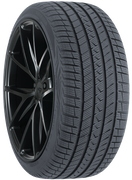
- All-Weather
- Quatrac Pro
-
- Severe Weather Rated
-
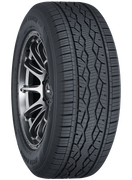
- Highway
- Open Range HTS
-
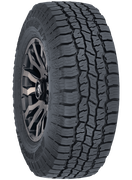
- All-Terrain
- Open Range A/T Plus
-
- Severe Weather Rated
-
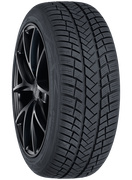
- Winter/Snow
- Wintrac Pro
-
- Severe Weather Rated
Maintain Traction This Season: Shop Tires at Your Local Les Schwab
The right tires can help keep you in control, whether you’re facing snow, ice, rain, or miles of stop-and-go traffic. Before you head out on your next road trip or weekend adventure, stop by Les Schwab. We’ll make personalized tire recommendations based on what you drive, where you live, and today’s ever-changing weather.

